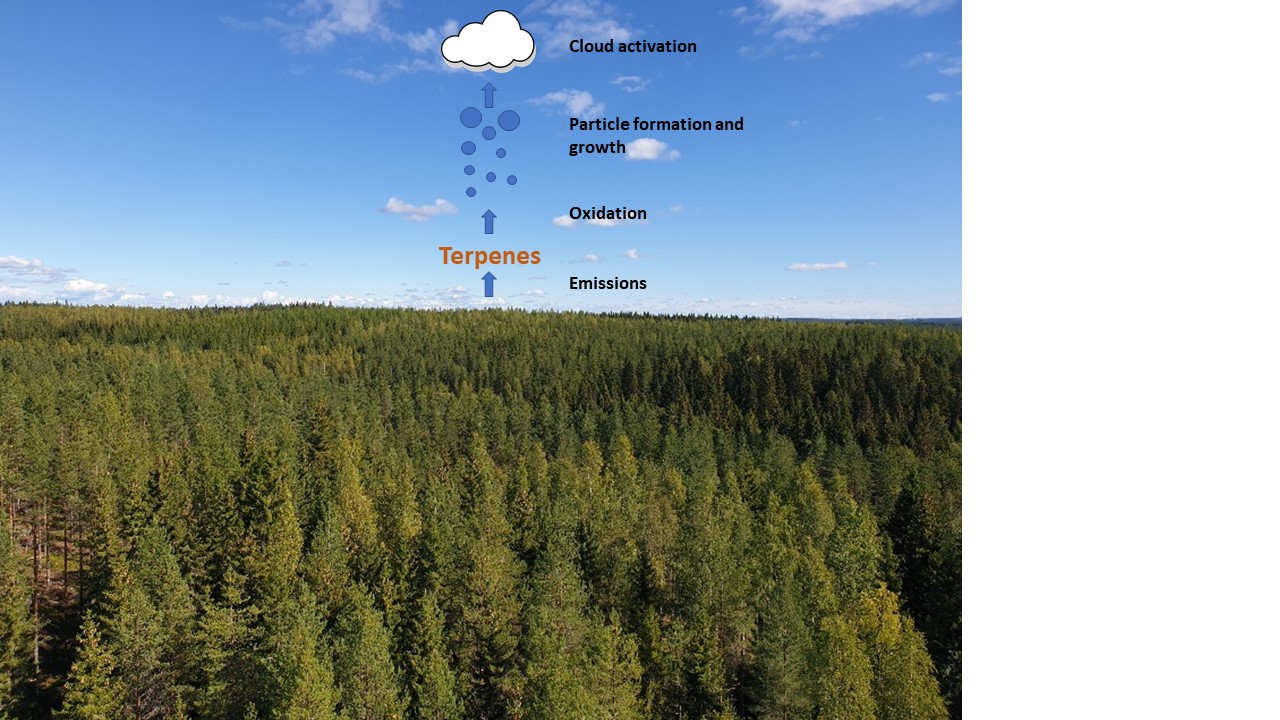Welcome to the blog of the project MetClimVOC!
December 2021
Terpenes in the atmosphere
Can you smell the scent of the forest? That smell is made of different gas molecules from the family of volatile organic compounds (VOCs). Terpenes represent an important class of these naturally emitted VOCs. Globally, it is estimated that VOC emissions from natural sources are ten times higher than emissions from human activities (Guenther et al., 2012)
# What are terpenes?
Terpenes are the largest class of natural occurring organic compounds. More than 40,000 terpene structures have been reported so far. They are classified according to the number of isoprene units they contain: monoterpenes (C10H16), sesquiterpenes (C15H24), diterpenes (C20H32), etc.
Forests are a major source of terpenes. While some forests emit mainly isoprene (C5H8), for example, boreal forests are strong terpene emitters (Figure 1).

# How do terpenes affect the atmosphere?
Terpenes are highly reactive with respect to atmospheric oxidants such as ozone (O3), the hydroxyl radical (OH), and the nitrate radical (NO3). Due to this reactivity, their atmospheric lifetimes are short, ranging from minutes to days in the case of mono- and sesquiterpenes.
Terpenes impacts greatly the oxidative capacity of the atmosphere and the formation and destruction of ozone. They also participate in the formation and growth of new particles and clouds, impacting climate (Jokinen et al., 2012 and Figure 1).
Furthermore, most of the terpenes emitted have a therapeutic potential for inflammatory diseases as result of their anti-inflammatory effects as well as their function against oxidative stress (Kim et al., 2020).
# How are atmospheric terpenes measured?
Due to the high reactivity and very low ambient concentrations of terpenes, their quantification is challenging. Atmospheric terpenes have been studied using both direct mass spectrometric and chromatographic methods (Figure 2).

With direct mass spectrometric techniques, high time resolution (even seconds) can be achieved, but they lack the species specific information and all monoterpenes or sesquiterpenes are detected as a sum. The most common direct mass spectrometric method is proton transfer reaction mass spectrometry (PTR-MS).
For measurements of specific terpene species, chromatographic methods with lower time resolution (e.g., one hour) are used. Typical instrumentation consists of thermal desorpters together with gas chromatographs and mass spectrometers and/or flame ionization detectors (TD-GC-MS/FID).
In addition, off-line measurements of terpenes are possible by using sorbent tube sampling. These samples can be taken for instance at locations with minimal or no infrastructure and analysed later in the laboratory.
Within the MetClimVOC project, we develop and evaluate these methods to enable more accurate measurements of terpenes.
#About the authors
Heidi Hellén, head of the Air Quality group at the Finish Meteorological Institute (FMI), is an expert on VOC measurements. She has a long experience on measurements of terpenes. She has studied biogenic VOCs in a variety of projects, resulting in the publication of 87 research articles, which are related mainly to VOCs in the atmosphere and their emissions. She is also a docent of air chemistry at the University of Helsinki.

Arnaud Praplan is a senior scientist (Academy research fellow) in the Air Quality group at FMI. His research focus on total reactivity measurements as a tool to assess how comprehensively biogenic emissions have been characterized. His research, mostly in atmospheric chemistry, has been published in 43 peer-reviewed articles.
# Latest post
Go back to the latest blog post.
# Other posts
In this section, you can find the links to previous blog posts.
February 2022 - Reference gas mixtures for oxy-VOCs
October 2021 - Monitoring halogenated VOCs from the space
June 2021 - One year of project MetClimVOC!
March 2021 - How gas surface interactions can affect VOC monitoring?
January 2021 - Halogenated VOCs in the atmosphere: monitoring and traceability
November 2020 - Atmospheric trace gases: VOCs, impact climate change
September 2020 - Welcome to the blog of the project MetClimVOC!